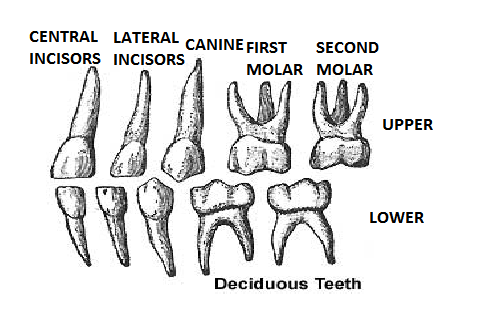 This diagram shows the first baby teeth growing in the mother’s uterus
This diagram shows the first baby teeth growing in the mother’s uterus
So, how do baby’s teeth grow ? The baby teeth actually starts growing during the 6th week in the mothers uterus. These baby teeth growth starts with the Bell shape tooth germ. This Bell shape structure seen is actually the enamel organ, which will eventually grow into a baby teeth. As you can see the enamel organ or tooth germ contains numerous cells. These cells will continue to grow and differentiate into different and more advance cells to form the tooth. The outer and inner enamel organ eventually forms the outer casing of the tooth called the enamel layer. Where else the dental papilla cells will form the inner section of the tooth known as the pulp chamber. The permanent tooth bud will continue to grow into the permanent teeth after the baby tooth eruption is completed in the mouth.
 The completed growing teeth erupting in the baby’s mouth
The completed growing teeth erupting in the baby’s mouth
The completed tooth structure is shown in the diagram on the left. As you can see above the tooth starts growing from little cell structures, but eventually forms a tooth shape and different layers of structures. The outermost layer is the tooth enamel. The tooth enamel is a hard crystallized structure usually opaque or translucent. It is the outer most shell of the growing tooth, only a diamond coated instrument can cut through it. So you might ask, if its so strong why do we get decay ? the reason being is that when the growing tooth is decayed the mineral structure is lost , therefore the strength of the enamel crystals are compromised leading to the collapse of the structure and invasion of bacteria into the tooth. The second outer most is the dentine layer, this layer contains many dentinal tubules which in it has dentinal fluid, the change in pressure of the fluid can cause us to feel the pain sensation. This sensation is commonly known as sensitivity. The innermost layer is the pulp chamber which contains the blood vessels and nerve vessels. Usually if very severe throbbing pain is felt, it means that the pulp chamber has been compromised and the removal of the pulp through root canal therapy is indicated.
| Primary Teeth Development Chart | ||
| Upper Teeth | When tooth emerges | When you are going to be loosing that baby teeth |
| Central incisor | 8 to 12 months | 6 to 7 years |
| Lateral incisor | 9 to 13 months | 7 to 8 years |
| Canine (cuspid) | 16 to 22 months | 10 to 12 years |
| First molar | 13 to 19 months | 9 to 11 years |
| Second molar | 25 to 33 months | 10 to 12 years |
| Lower Teeth | ||
| Second molar | 23 to 31 months | 10 to 12 years |
| First molar | 14 to 18 months | 9 to 11 years |
| Canine (cuspid) | 17 to 23 months | 9 to 12 years |
| Lateral incisor | 10 to 16 months | 7 to 8 years |
| Central incisor | 6 to 10 months | 6 to 7 years |
Baby teeth schedule growing out
When babies start to grow teeth , the process is called teething babies. As seen from the chart, the baby’s first tooth begin to break through the gums at about 6 months of age. Usually, the first two baby teeth to erupt are the two bottom central incisors (the two bottom front teeth). Next, the top four front baby teeth emerge. After that, other baby teeth slowly begin to fill in, usually in pairs – one each side of the upper or lower jaw – until all 20 baby teeth (10 in the upper jaw and 10 in the lower jaw) have come in by the time the child is 2 ½ to 3 years old. The complete set of baby teeth is in the mouth from the age of 2 ½ to 3 years of age to 6 to 7 years of age.
Other baby tooth eruption facts:
- A general rule of thumb is that for every 6 months of life, approximately 4 baby teeth will erupt.
- Girls generally are faster than boys in baby tooth eruption
- Lower teeth usually erupt before upper teeth
- Teeth in both jaws usually erupt in pairs , one on the right and one on the left
- Baby teeth are smaller in size and whiter in color than the permanent teeth that will follow
- By the time a child is 2 to 3 years of age, all baby teeth should have erupted
Shortly after age 4, the jaw and facial bones of the child begin to grow, creating spaces between the baby teeth. This is a perfectly natural growth process that provides the necessary space for the larger permanent teeth to emerge. Between the ages of 6 and 12, a mixture of both baby teeth and permanent teeth reside in the mouth.
Importance of baby teeth
Baby teeth are as important as permanent teeth. Most people will say that, why should they care for baby teeth when eventually they are all going to fall out anyway. This is where most peoplae are mistaken, baby teeth actually help keep the space vacant for the permanent teeth, without it the permanent teeth will not know where to erupt in the mouth. Therefore, brushing baby teeth must be done. If the baby is still very young, use a wet towel as a substitute for a toothbrush.

Pingback: Common Questions asked about baby's erupting teeth | Intelligent Dental